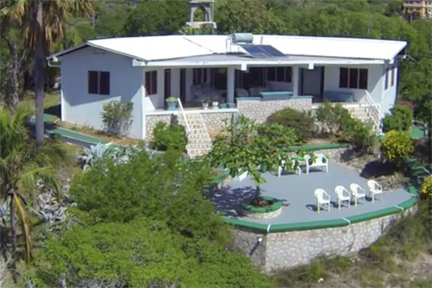“Have you built houses before this?” the banker asked. “In Japan, maybe?”
“No,” I had to admit, “but it’s a fairly simple design.”
It was 1958. After college, my wife and I had spent more than two years on a Quaker service project in Japan, and then a year making our way home through Asia,
the Mideast and Europe. We had lived out of knapsacks, shamelessly freeloading from friends and even from new acquaintances, spending hardly more than a ship home would have cost. I was now a bit more than a year into my first real job as reporter for the evening Hartford Times.
And I wanted to borrow $10,000 for materials with which I would build a house.
It would be small, one-story, slab-on-grade; L-shaped. The long leg would comprise two authentic Japanese bedrooms with tatami straw-mat floors and shoji sliding paper doors. The shell would be of concrete block, but the inside of both wings would face out through full-length Thermopane sliding doors onto a patio garden paved with used brick. The focal point of that garden would be a four-foot-long slab of granite that I had already pried out of the bedrock; we would set it on end, a Zen touch.
We had bought 17 acres of meadow, pond and woods in the Connecticut countryside, had a well drilled, and had temporary electricity strung in from the road. I had built (my only construction experience, not enough to impress a banker) a pumphouse/toolshed big enough to be kitchen and cramped living space until the house was built (we and our year-old daughter Emily would sleep in a big tent on a proper platform). I’d costed out materials, allowed for a few days of hired expertise, and was eager to start.
Had the banker pressed, I might have had to confess that I’d almost flunked my junior high shop course, until my engineer father began coaching me; that my work in Japan had more often entailed paint brushes than hammers, trowels or saws (we had organized college-age youth into volunteer work camps, often visiting nursing homes or orphanages that always needed help).
The conversation never got that far. “Come back when it’s finished,” the banker said, “and we’ll arrange a mortgage.” Happily, my mother-in-law could and did guarantee a construction loan (from another bank; why reward skepticism?) and we were soon under way.
First, I hired a tractor and backhoe to clear the site of stumps and rough out trenches (bedrock being only a few feet down), in which I framed footings. A ready-mix truck operator was extra helpful one October Saturday, as a half-dozen fellow Times reporters helped shovel concrete all the way around and level it. That base was then left to cure for the winter.
Although early April was still chilly, we moved out and began building. It was a grind: At work early, I was home by four most afternoons and worked (under strategically-placed lights) until 9 or 10, although some nights I had to drive back into town to cover school board and town council meetings in West Hartford, my assigned beat.
My dear wife Brad (one of a half-dozen freshman Bettys at Oberlin College, she’d taken a lifelong nickname) spent much of her days making my hours more productive. Abetted or encumbered by a just-walking child, she used a long hose from the pumphouse to fill barrels of water for mortar-mixing, carted sacks of cement and even stacked some concrete blocks where needed. We had only one car, a VW Beetle; some afternoons she and Emily made a supermarket run while I started work. Our un-cosseted daughter spent her first birthday picking wild blueberries for a celebratory pie baked in a camp oven over a kerosene stove.
My output was vastly improved by our nearest neighbor, who’d recently retired from a career as what was then called ‘clerk of the works’ on major construction projects: a hawkeye who made sure the owners got what the architects specified. We called him Uncle Fred; he was an avuncular man whose life experience would not have taught him the meaning of that word.
Bringing his cocker spaniel on a quarter-mile walk every evening, he did what he’d spent his life doing. “Come look at your wall from this corner,” he said early on. “You’re developing a wallop.” I came and squinted: Sure enough, a bit of curvature in what was meant to be a straight flat wall! He showed me how to bring it straight and true in the next two courses, and how thereafter to follow a taut string to keep it flat–the first of many bits of expert advice.
I sought out other free wisdom. My daily commute was almost 25 miles, and I kept assiduous track of houses being built along the way. More than once I drove in, explained that I was building my own house and was at about the same stage, and begged to be shown how some sophisticated bit of masonry or carpentry should be done.
There were a few things that needed not only extra hands, but special skills. Those sliding doors, the single most expensive element of building material, were heavy as sin, thanks to double-glass insulating; they had to be absolutely level horizontally and absolutely 90-degrees vertically. The burly men who brought them also patiently helped shim them true, and before leaving helped secure them firmly enough that they would stay forever where we put them.
I hired only three days of skilled labor. A carpenter helped me frame a roof with complicated hips and valleys. A plumber-electrician helped lay the sewer line (which had to run partially under the house, leaving no room for error), and would come back to inspect (and approve) every one of my electrical connections before the power company would energize them.
Meantime, I coaxed hours of work out of newspaper colleagues. My managing editor spent a Saturday with a hammer, nailing plywood onto the roof. That proved the easy part: onto the plywood went tarpaper; hot tar was then poured and mopped on, with a thick coat of fine white gravel imbedded in the tar. That sparkling white roof, absolutely impervious to weather, was an ornament to the house. Not a few of my volunteer colleagues took home sneakers spattered with tar, and some had blisters here and there to remind them how hot the tar had been.
The house finally enclosed, it was time to work on interior walls and ceilings, closets, pocket doors, plumbing and lighting. The tracks for the sliding paper doors in the bedrooms were demanding: I finally found knotless, smooth-grained white pine into which I could neatly rabbet out, top and bottom, the groove slots in which the doors would slide open and shut. I bought the shoji themselves, as well as the tatami mats, from a specialty shop in Manhattan.
The bathroom had to have both a shower and a sit-up-deep ofuro tub. I cast the tub out of a special pink cement in which colored gravel chips were embedded; then with a rented heavy electric tool ground off enough cement to reveal the stones handsomely.
The living room was just big enough to accommodate a dining table and chairs, along with smallish upholstered chairs and a sofa. On the far side was a relatively new invention, a Heatilator fireplace designed to circulate air and throw out real heat. That metal shell spared me a complicated design task, but it depended on the chimney I built. Thank goodness, it drew nicely the first time I brought in some logs and tried it out.
Finally I installed the electric-heat baseboards we’d chosen, and called my plumber-electrician to inspect. He in due course phoned the power company to report, and climbed a pole at the street to make the electrical supply permanent. In a few minutes, thanks to those baseboards, the whole house began to be toasty warm.
Just in time: It was October again, and nights had become downright nippy. We happily abandoned the frigid tent and cramped toolshed and moved into our new house.
Not that it was anything near finished; at that point, it was barely functional. That first night, for example, the only source of water in the whole house was the cold-water faucet at the kitchen sink. We had to use it carefully, because the sink drain wasn’t hooked up yet; the only place water could leave the house was the toilet. Happily, the bathroom adjoined the kitchen; it was a short trip to dispose of dishwater or flush the toilet–sometimes both accomplished at once.
I spent most of that winter finishing up fine points, albeit at a relatively relaxed pace. We got to know the neighbors better, including Mabel Fenn, a grandmotherly woman whose wiry husband Seeley felled trees and single-handedly cut them into firewood with a two-man saw. They grew and preserved most of what they ate, and were the quintessence of economical living.
After the better part of a year of long days and short nights building a house, Brad and I could finally go out to a concert or movie; Mrs. Fenn became our babysitter. We came home from our first outing to find the house pitch-dark. Finally, as we drove up, a light came on. Had she been napping? we asked. “Goodness, no!” Then why no lights on? “Warn’t reading; no point in wasting electricity.” She always sat in the dark after reading Emily to sleep, the epitome of New England frugality.
It was our dream house, the best we were to live in through 65 years of marriage. Thanks in part to my broadening reportorial assignments, however, we were increasingly aware of racial inequities in our core city, and felt called to be part of redressing prejudice. A few Black families had moved into Blue Hills, a handsome residential Hartford neighborhood, triggering a white exodus hastened by real estate agents’ racial steering.
We decided to move to Blue Hills. We easily found a superb three-story house on a long block of some architectural distinction, and reluctantly abandoned our country triumph.
For the first few years, we rented our dream house to a friend. When it became clear we were city residents who would never be affluent enough to keep a country home for only occasional weekends, she happily bought it. There have been several owners in the years since, but the house we built is still there, sturdy and unique.
I’m alone now; our (retired!) daughter looks in on me often, and I enjoy a comfortable old age. But every now and then I waken to imagine that we are all back in that house we built: I can tiptoe up to slide open the shoji paper doors and the big glass doors, bringing in cool fresh air and birdsong from our surrounding forest, an ambience in which we can luxuriate abed a little longer.
It is a happy memory.






Love this!
Fascinating story, all the more remarkable knowing you were reporting on West Hartford meetings and working downtown in your work clothes! Oh to be young and full of happy memories.
What a beautiful story of making a house a home from the very construction of it. I so love this story!